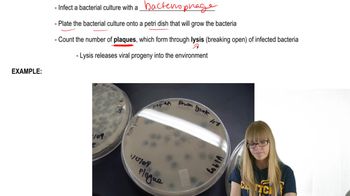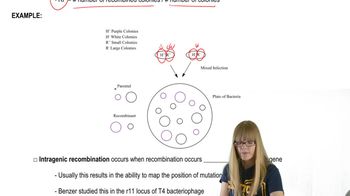5. Genetics of Bacteria and Viruses
Bacteriophage Genetics
5. Genetics of Bacteria and Viruses
Bacteriophage Genetics
Practice this topic
- Multiple Choice
A plaque assay studies viruses through what measurement?
- Multiple Choice
A mixed infection of two bacteriophage strains is often used for what purpose?
- Multiple Choice
A mixed infection of two bacteriophage strains was performed. Infection of bacteriophage strain 1 causes the bacteria to be red and large, while infection of bacteriophage strain 2 causes the bacteria colony to be black and small. The following results were obtained. Using this data, determine the distance between the color and size genes.
- Open QuestionIn this chapter, we have focused on genetic systems present in bacteria and on the viruses that use bacteria as hosts (bacteriophages). In particular, we discussed mechanisms by which bacteria and their phages undergo genetic recombination, which allows geneticists to map bacterial and bacteriophage chromosomes. In the process, we found many opportunities to consider how this information was acquired. From the explanations given in the chapter, what answers would you propose to the following questions?How do we know that in bacteriophage T4 the rII locus is subdivided into two regions, or cistrons?
- Open QuestionIn this chapter, we have focused on genetic systems present in bacteria and on the viruses that use bacteria as hosts (bacteriophages). In particular, we discussed mechanisms by which bacteria and their phages undergo genetic recombination, which allows geneticists to map bacterial and bacteriophage chromosomes. In the process, we found many opportunities to consider how this information was acquired. From the explanations given in the chapter, what answers would you propose to the following questions?How do we know that intergenic exchange occurs in bacteriophages?
- Open QuestionWrite a short summary that contrasts how recombination occurs in bacteria and bacteriophages.
- Open Question
Describe what is meant by the term site-specific recombination as used in identifying the processes that lead to the integration of temperate bacteriophages into host bacterial chromosomes during lysogeny or to the formation of specialized transducing phage.


